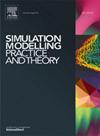Discrete element modelling of water diffusion and softening characteristics in rocks
IF 3.5
2区 计算机科学
Q2 COMPUTER SCIENCE, INTERDISCIPLINARY APPLICATIONS
引用次数: 0
Abstract
The water softening effect is a critical factor that can cause or exacerbate large deformation phenomena or even instability in rock engineering. In this study, a meso water diffusion and softening model is proposed based on the discrete element method, the theory of saturated-unsaturated seepage and damage theory, which can be used to characterize the moisture diffusion process between rock pores quantitatively, as well as the mechanical behaviour of rock particles undergoing parameter deterioration subjected to a water-induced softening effect. In addition, by comparing the simulated values with the results of mercury intrusion, water absorption and uniaxial compression tests, the rationality of the proposed model has been validated. Furthermore, the relationships between the saturation coefficients and the mechanical parameters of rock samples are researched, and the moisture distribution characteristics of rock samples and their impacts on the meso mechanical parameters under water absorption, evaporation and closed boundary conditions are studied, as well as the evolution of the number of microcracks in rock samples during uniaxial compression tests. The research results indicate that the strength and stiffness parameters of the particle elements exhibit non-linear degradation with increasing saturation coefficient. With the same saturation coefficient, the degradation degree of the uniaxial compressive strength and elastic modulus of the sample during the evaporation process is usually greater than that of the sample during the saturation process. Compared with that in the low-saturation samples, the number of cracks in the high-saturation samples significantly increased under water absorption conditions. In contrast, the number of cracks in the sample does not change significantly with decreasing saturation under evaporation conditions. The proposed model provides a new approach for studying the water-softening effect in rocks using the discrete element method.
岩石中水扩散和软化特性的离散元模拟
在岩石工程中,水软化效应是引起或加剧大变形现象甚至失稳的关键因素。本文基于离散元法、饱和-非饱和渗流理论和损伤理论,建立了细观水扩散软化模型,定量表征岩石孔隙间水分扩散过程,以及岩石颗粒在水致软化作用下参数劣化的力学行为。此外,将模拟值与压汞、吸水和单轴压缩试验结果进行对比,验证了模型的合理性。进一步研究了饱和系数与岩样力学参数之间的关系,研究了吸水、蒸发和封闭边界条件下岩样的水分分布特征及其对细观力学参数的影响,以及单轴压缩试验中岩样微裂纹数量的演变规律。研究结果表明,随着饱和系数的增大,颗粒单元的强度和刚度参数呈非线性退化。相同饱和系数下,试样在蒸发过程中单轴抗压强度和弹性模量的退化程度通常大于饱和过程中试样的退化程度。与低饱和度试样相比,吸水条件下高饱和度试样的裂纹数量显著增加。相比之下,在蒸发条件下,随着饱和度的降低,试样中的裂纹数量变化不明显。该模型为用离散元法研究岩石中的水软化效应提供了新的途径。
本文章由计算机程序翻译,如有差异,请以英文原文为准。
求助全文
约1分钟内获得全文
求助全文
来源期刊

Simulation Modelling Practice and Theory
工程技术-计算机:跨学科应用
CiteScore
9.80
自引率
4.80%
发文量
142
审稿时长
21 days
期刊介绍:
The journal Simulation Modelling Practice and Theory provides a forum for original, high-quality papers dealing with any aspect of systems simulation and modelling.
The journal aims at being a reference and a powerful tool to all those professionally active and/or interested in the methods and applications of simulation. Submitted papers will be peer reviewed and must significantly contribute to modelling and simulation in general or use modelling and simulation in application areas.
Paper submission is solicited on:
• theoretical aspects of modelling and simulation including formal modelling, model-checking, random number generators, sensitivity analysis, variance reduction techniques, experimental design, meta-modelling, methods and algorithms for validation and verification, selection and comparison procedures etc.;
• methodology and application of modelling and simulation in any area, including computer systems, networks, real-time and embedded systems, mobile and intelligent agents, manufacturing and transportation systems, management, engineering, biomedical engineering, economics, ecology and environment, education, transaction handling, etc.;
• simulation languages and environments including those, specific to distributed computing, grid computing, high performance computers or computer networks, etc.;
• distributed and real-time simulation, simulation interoperability;
• tools for high performance computing simulation, including dedicated architectures and parallel computing.
 求助内容:
求助内容: 应助结果提醒方式:
应助结果提醒方式:


